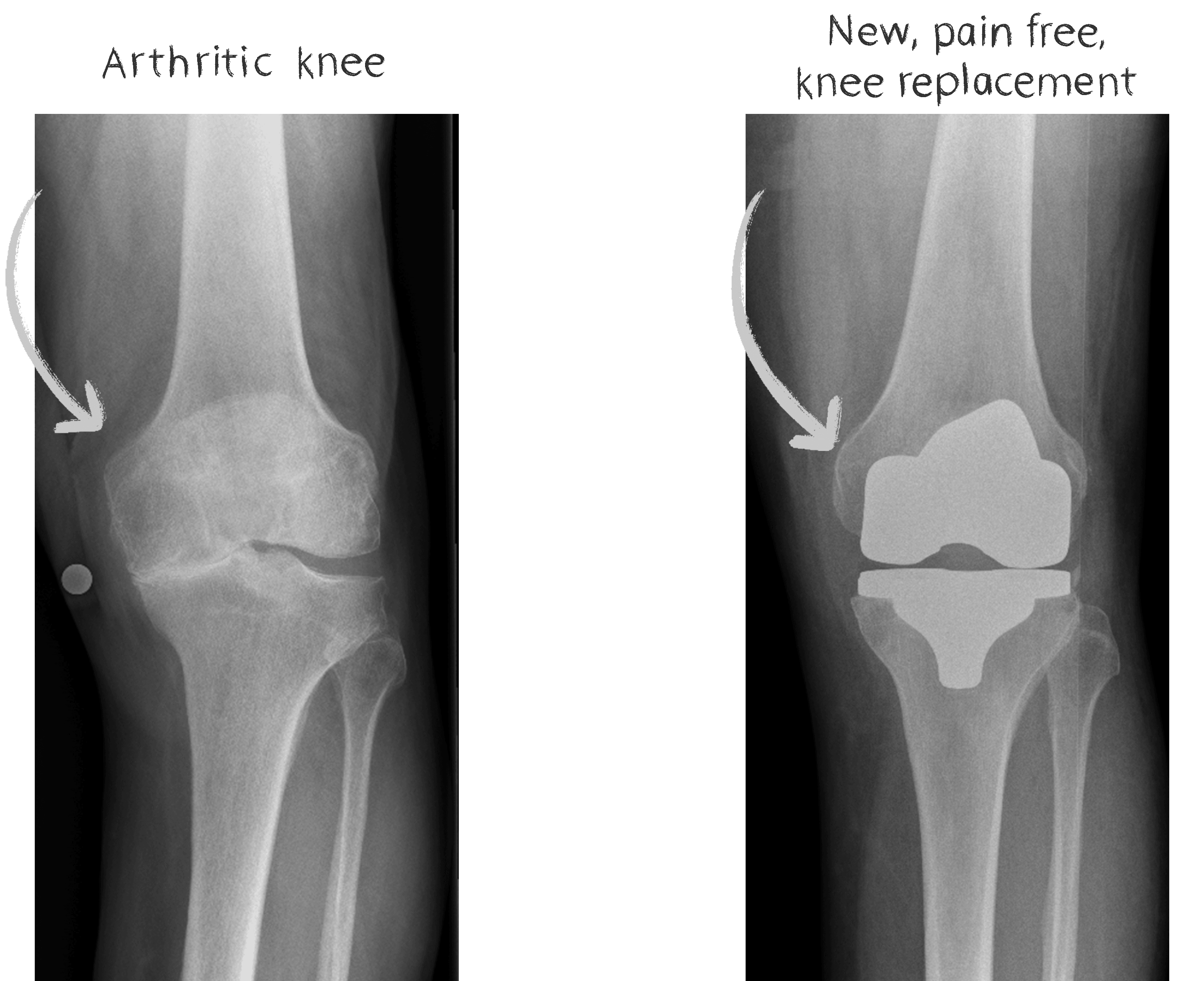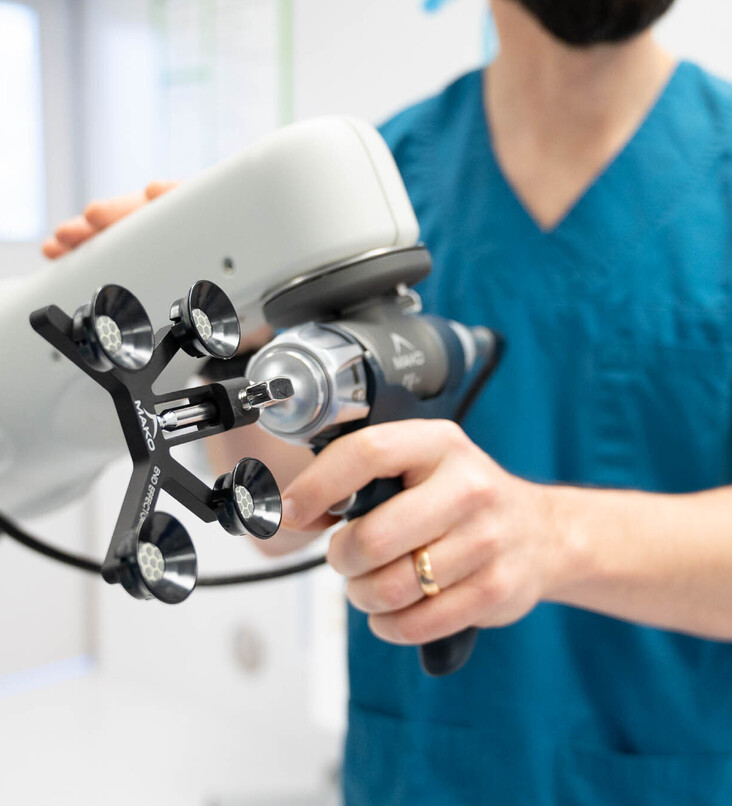Total Knee Replacement (TKR)
Overview of total knee replacement
Total knee replacement is an operation whereby a surgeon removes the worn out ends of the bones that make up the knee joint and replaces them with a prosthetic joint. The joint replacement has four major parts.
Femoral component
Tibial baseplate
Bearing surface
Patella component
Knee replacement surgery has been performed for 50 years and over this time many improvements have been made. It is now considered one of the most successful operations at treating end-stage arthritis of the knee.
Conditions treated with a total knee replacement
Osteoarthritis (most common)
Inflammatory arthritis
Post-traumatic arthritis
Avascular necrosis

FAQs about total knee replacement
How is the surgery conducted?
The surgery is usually performed under spinal anaesthetic block. The anesthetist injects a numbing solution into your back which lasts up to 4 hours and provides excellent pain relief. We also offer the patient sedation to allow them to sleep during the case. We then position you on the operating table. Once the knee is draped and covered in antiseptic agent, the knee joint is exposed and the worn out ends of the bones are removed and replaced with prosthetic ends. A polyethylene liner (bearing) is inserted between the metal ends and the patella is also resurfaced. The knee is closed. Dissolving sutures are used in the skin. You are then awoken and taken to the recovery room.
What should I do before my surgery?
Prehab
Undergoing active physical therapy several months prior to your surgery
This aims to strengthen your muscles, improve joint flexibility, and improve cardiovascular health to minimise complication risks and to improve function after the joint replacement
Scheduling an appointment with your GP to improve baseline health
Ensuring blood pressure is adequately treated
Medications are reviewed to ensure correct doses and timing, this is called Medication Reconciliation
If you have diabetes, make sure your blood sugars are well controlled and your HbA1c is as low as possible
Weight loss
If you are overweight, weight loss helps in many different ways
It improves access for your surgeon, leading to better component positioning
It reduces risks with anaesthetics
It has been shown to improve function and satisfaction after surgery
Can reduce the risk of infection if your BMI >40
Skincare
Your skin is the main barrier to keeping bacteria out of your joint replacement
Healthy skin is very important
Cuts and scratches may prevent the surgeon being able to perform the surgery on the day
Dry, flaking skin, cracked skin can act as a portal for bacteria to enter your body and cause both local infections and deep infections of the joint replacement
Keeping the skin moisturized, clean, and scratch free is beneficial
Good Dentition
If you have cracked teeth, or gum pain, you should consult your dentist and have a through dental exam.
Infection of the joint replacement can be caused by poor oral health and this is a severe complication
Stop smoking if you are a smoker
Reduce alcohol use to a minimum
What are the risks of surgery?
Infection
Venous thromboembolism
Post-operative stiffness
Incomplete relief of pain
Instabililty
Aseptic loosening
Fracture
Medical complications
- Pneumonia
- Stroke
- Myocardial infarction
For detailed information, please refer to our “Risk associated with Total Knee Replacement”.
What can I do/should not do after my total knee replacement?
You will be able to gradually increase your activity levels from the day of surgery. Come 6 weeks, most people are back to their usual daily activities. By 6 months, studies show the vast majority of patients have fully recovered. You will eventually be able to return to activities such as walking, hiking, cycling, swimming, skiing, and golf.
What type of implant is used?
There are many implant companies and implants available for use in NZ. All of them have met stringent requirements to be allowed to be used. Hamish McLaren uses one of the most commonly implanted total knee replacements. This implant has over 20 years of follow up data, with an excellent track record. The knee replacement has both cemented and uncemented options. The implants are constructed of a cobalt-chrome alloy and titanium. The bearing and patella components are made from highly crosslinked polyethylene which is extremely hardwearing.
What is the recovery process after surgery?
Please see our Pre-op Handbook for a detailed description of this.
You will transfer to the ward after surgery. You will be met by your nurse and encouraged to get out of bed and start walking once the spinal anaesthetic wears off. You will be seen by Hamish McLaren each day on the ward round. Physiotherapists will work with you several times each day. This is aimed at improving your gait, range of motion and some light strengthening. Pain will be controlled with tablets, usually requiring some form of opiate. Most people are in hospital for 2-3 days. When you return home, you will still require some help from family or friends for the first 2 weeks. You will have physiotherapy exercises to perform at home, these are important to get the best out of your knee replacement. You will have crutches for the first 4-6 weeks. By 6 weeks most people are getting back to everyday activities, by 6 months you are fully recovered.
When can I return to work?
This is highly dependent upon your occupation
Sedentary office-based work - 6 weeks or potentially earlier
Heavier labour-type jobs - can be up to 3 months
When will I be able to drive?
You can drive from 4 weeks after your surgery



